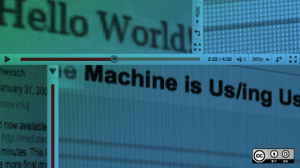How/why the text is important to field its field/the field of new media

Creative Commons licensed image by OpenSource.com on Flickr https://www.flickr.com/photos/opensourceway/4371001144/
- Current rhetorical practices in the classroom disregard the canon of delivery, preferring to focus instead on the “canons of arrangement and style, the organization and artful expression of written discourse” (57-58). Delagrange challenges the status quo and encourages a new vision for the rhetorical classroom: “I make a case for designing multimediated alternatives to logocentric, linear print models of scholarship. I argue that digital interactivity and multimodality (particularly the emphasis on visual rhetoric and representation) provide opportunities for scholarly inquiry that have no equivalent in print, yet are equally as rigorous intellectually. In so doing, I also show the necessity of adopting new criteria for evaluating scholarly digital media that demonstrate the inadequacy of efficiency and transparency as either necessary or sufficient standards for scholarly work” (20). Even if her challenge is not accepted by the establishment at large, it continues the conversation and pushes us to question not only our motives, but our methods.
How the text engaged in scholarly field (read reviews and articles using)
- Bernhardt, Stephen A. “Rhetorical Technologies, Technological Rhetorics.” College Composition and Communication 64.4 (Jun 2013): 704-720. ProQuest. Web. 10 Nov. 2014.
- Bernhardt reviews 5 different texts, including Delagrange’s online text
- Gaillet, Lynee Lewis. “Reinscribing Histories.” South Atlantic Review 76.4 (Fall 2011): 171-80. Academic OneFile. Web. 10 Nov. 2014.
- Gaillet reviews three books and says of Delagrange’s work, “I find Technologies of Wonder to be smart, innovative, and engaging. This work fully illustrates potentialities within digital publishing and offers a wealth of resources for reimagining pedagogy, even for teachers who are leery of technology” (179).
- Hawisher, Gail E., and Cynthia L. Selfe. “Evolving Digital Publishing Opportunities Across Composition Studies.” Composition Studies 42.1 (Spring 2014): 107+. ProQuest. Web. 10 Nov. 2014.
- While the main focus of this article involves digital publishing, the fact that Delagrange’s Award-Winning book is mentioned gives credibility not only to the publishers but to Delagrange
- Kurlinkus, William Campbell. “Crafting Designs: An Archaeology of ‘Craft’ as God Term.” Computers and Composition 33 (2014): 50-67. ScienceDirect. Web. 10 Nov. 2014.
- This article pulls ideas from Delagrange’s book and connects it to the concept of design
- Stamper, Amber M. http://kairos.technorhetoric.net/18.1/reviews/stamper/index.htm
- Review/overview
Skip to:
Main Project Page
Summary
Key Terms + “New Media”
In the Production Process
Engaging New Media & Lingua Fracta